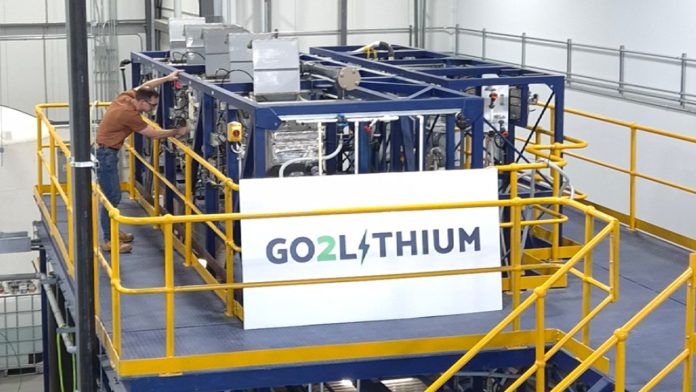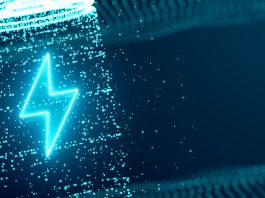Go2Lithium has developed an innovative technology to enable more efficient and cost-effective extraction of lithium from low-concentration brines.
Go2Lithium is transforming the lithium extraction industry with its groundbreaking technologies and forward-thinking initiatives. This article delves into Go2Lithium’s unique continuous counter-current processing technology, the advanced continuous Direct Lithium Extraction (cDLE®) method, and the recent milestone of opening a pilot plant at LithiumBank Resources Corp. (LithiumBank) facility in Calgary, Canada.
cDLE® continuous counter-current processing technology
Go2Lithium’s continuous counter-current processing technology is a significant leap forward in lithium extraction. cDLE® is a true moving bed process, where the sorbent is transferred between the unit processes of sorption, washing and desorption. The cDLE® process can use either ion exchanger or adsorbents depending on the lithium concentration, the total dissolved solids and the specific impurities in the brine.
In low-concentration brines, such as those with less than 100 mg/L Li, ion exchange is the preferred method in the cDLE® process. Thanks to its higher loading capacity and, subsequently, lower desorption volume requirements, ion exchange offers faster and more extensive lithium capture and upgrade than adsorption. With the right ion exchangers, 100 mg/L Li in the feed brine can be upgraded to over 3,000 mg/L in the DLE product, demonstrating the efficiency and cost-effectiveness of the cDLE® process.
When comparing DLE processes based on fixed beds, such as simulated moving beds (SMB carrousels, ISEP, Septor, Puritech) or lead-lag desorption, to cDLE®, significant differences become apparent. The cDLE® process, by its nature, can handle a more variable feed flow, feed lithium and impurity concentrations, including suspended solids, and can use lower-cost chemical reagents. This unique adaptability of the cDLE® process can significantly reduce pretreatment expenses, making it a more cost-effective and viable option.
The choice of sorbent for DLE is an ongoing debate. Adsorbents, particularly those based around aluminium, have a long history of use and are generally considered to be a lower risk. However, the decision to use adsorption must also consider the trade-offs. While adsorption may lead to a lower risk, it also results in a lower lithium upgrade and higher freshwater use, necessitating a larger refining process with associated capital and operating costs. This debate underscores the complexity of the decisions facing the lithium extraction industry.
The ion exchange sorbents are a relatively new innovation and, consequently, have not yet been used extensively in commercial plants. Like the aluminium-based adsorbents, the ion exchangers are generally minerals based on either manganese or titanium oxide mineral components. Due to the higher lithium loading capacity, ion exchangers offer a much better upgrade potential, which is attractive. The ion exchanger must be both mechanically and chemically robust as it is subject to large pH swings in the processing. The use of chemistry is touted as a negative for ion-exchanging processes. However, it must be said that adsorbents also need chemicals and extensive water management, albeit in the refining stages of the process.
The hydraulic flow and purity of the DLE eluate have a dramatic effect on the capital and operating costs of the lithium refining stages, so it is very important to understand the overall economics and make the decision on the sorbent and the process, taking into account both pretreatment and refining aspects.
cDLE® technology is designed to selectively target and upgrade the concentration of lithium ions while ensuring the impurities are mainly rejected. The counter-current process is used in both the ion exchange sorption and desorption processes, and the moving bed approach allows the use of lower-cost chemistries for pH control, with lime used in sorption and sulphuric acid in desorption.
The moving bed process is eminently scalable and can be easily modularised. The continuous nature allows for easy expansion as demand increases, making it a versatile solution for both small-scale and large-scale operations. In practice, moving bed processes have been operated at a commercial scale for the recovery of nickel, cobalt, scandium, vanadium, and uranium.
cDLE® pilot plant at LithiumBank
The recent opening of the cDLE® pilot plant at LithiumBank marks a significant milestone for Go2Lithium. The facility has a processing capacity of approximately 10,000 L/d of brine, making it one of the largest DLE pilot plants in North America. The pilot plant is set to demonstrate the practical applications of the company’s advanced technologies in a real-world setting.
The pilot plant will serve as a testing ground for Go2Lithium’s technologies, allowing the company to fine-tune its processes and demonstrate their effectiveness on a commercial scale. Located at LithiumBank’s Calgary facility, the cDLE® pilot plant is strategically positioned to take advantage of local lithium brine resources, ensuring a steady supply of raw materials for continuous testing and optimisation.
The pilot plant is a hub for collaboration with industry partners, researchers, and stakeholders, fostering an environment of innovation and knowledge sharing to drive further advancements in lithium extraction technology.
Implications for the lithium industry
Go2Lithium’s advancements have far-reaching implications for the lithium industry. By enhancing the efficiency and sustainability of lithium extraction, Go2Lithium is paving the way for a more environmentally responsible supply chain for this critical element.
The use of cost-effective chemical reagents, reduced water usage, and minimised environmental impact align with the increasing demand for sustainable mining practices.
Improved extraction efficiency translates to lower operational costs, making lithium more accessible and affordable for various applications, including electric vehicles and renewable energy storage.
Future of lithium extraction
As Go2Lithium continues to innovate and refine its technologies, the future of DLE lithium extraction technology looks promising. The use of continuous counter-current processing technology in cDLE® offers a blueprint for efficient, sustainable, and scalable lithium production, and the pilot plant at LithiumBank serves as a testament to these advancements.
Go2Lithium continues innovating in the DLE lithium extraction space to reduce the capex and opex of both the DLE process and with pretreatment and refining. Two examples are the use of graphene membranes in pretreatment and the application of the Clean-iX® continuous ion exchange for impurity removal.
Graphene membranes, operating as true molecular sieves down to 1,000 Daltons, offer pre-treatment at the nanofiltration level without rejecting salts. This allows salts to effectively pass through the membrane; high flux is obtained at low energy use.
The Clean-iX® process provides highly efficient and cost-effective removal of calcium, magnesium, boron, sodium, and potassium and can be easily coupled with concentration steps of reverse osmosis, forward osmosis, evaporation, and electrodialysis to complete the refining processes to battery-grade lithium salts.
Go2Lithium is well-positioned to lead the industry into a new era of sustainable lithium extraction.
Please note, this article will also appear in the 19th edition of our quarterly publication.









